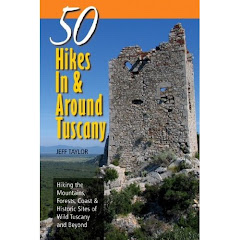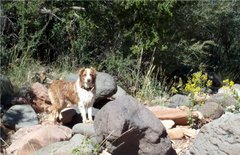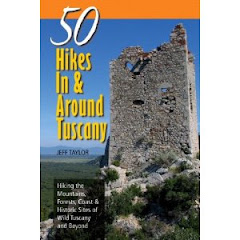Distance: 9.2 miles roundtrip (14.8 km)
Difficulty: Strenuous
Elevation: 7,700 - 10,418 feet (2,350 - 3,175 m)
Time of Year: Late April to Early November (start early during monsoon season)
 |
| The fire lookout at the summit |
At 10,418 feet in elevation, Kendrick Mountain stands as the 8th highest mountain in Arizona behind the San Francisco Peaks, several peaks in the White Mountains, and Mount Graham in southern Arizona. But, what makes Kendrick Mountain really stand out is its geographic prominence. As an extinct volcanic dome, it stands all alone on the Coconino Plateau with a view that spans the entirety of Northern Arizona. In fact, from it's summit you can see all the way north into Utah, west to the edge of California, south to Phoenix, and east nearly to New Mexico. While it is a haul to get up there, requiring a 2,500 foot climb, it is well worth the effort to sit at the edge of the sky and view out across such an expansive landscape.
 |
| A view of the summit from near the trailhead |
To get to Kendrick Peak from Downtown Flagstaff, drive north on Hwy 180 (the route to the Grand Canyon) for 14 miles until you reach FR 245 (well signed). Turn left and drive on this well-maintained dirt road for 3 miles until intersecting with FR 171 (also well signed). Turn right and follow it until reaching the sign for the trailhead, where you swing right and then there is a large parking area.
 |
| On the way up |
The trail immediately starts climbing, gradually at first, but it gets steeper and steeper as you go. Initially you are in a dense Ponderosa pine forest, but the Pumpkin Fire of 2000 cleared out a number of areas that give you good views throughout the hike. The trail starts by going around the edge of a small hill following an old road grade. This old road covers the first 1/3 of the hike until reaching a saddle between a smaller sub-peak and the main peak still rising 2000 feet above you.
 |
| Ever expanding views as you climb higher |
The trail begins to steepen and switchback up the side of the mountain as a it heads tangentially along a steep drainage and toward a higher saddle between the main summit peak and a ridge extending east. The trail will slowly transition from Ponderosa pines to Douglas firs, occasional aspen, and eventually will be joined by white pines and subalpine firs further up.
Eventually you will reach the saddle at 4.1 miles from the trailhead where things flatten out, Englemann spruce become evident and a nice grassy meadow of bunchgrasses predominate. There you will find a cabin built in 1912 to house the fire lookout workers. Catch a breathe, because you still have 1/2 mile left of trail and some 300 feet of climbing to get to the fire lookout. Due to the thick spruces on the north-facing slopes, you still can not look off to the north yet, only the same southerly direction you saw coming up. To see the Grand Canyon and beyond, keep climbing. While I have never really noticed the effects of elevation while hiking before, I do believe I felt it on this final stretch. That, or I am just getting out of shape. But, I was exhausted upon reaching the summit.
At the fire lookout, there is a helicopter pad that makes an excellent resting and eating place to admire a 180 degree view. Looking north-northeast you can see 10,000 foot Navajo Mountain in southern Utah rising beyond the Painted Desert of the Navajo Reservation.
 |
| A view across the Painted Desert with Navajo Mountain in Utah visible in the far distance |
Due north the Grand Canyon clearly visible. The North Rim rises 1,000 feet higher than the South Rim. You can see the gentle curving dome shape of the Kaibab Plateau and imagine how it formed a smooth surface to the South Rim before the Colorado River ate into it some 5,000 feet down. In addition, with binoculars, which I had, you could easily see several of the major geologic layers on the North Rim.
 |
| The North Rim rises 1,000 feet higher than the South Rim of the Grand Canyon A prescribed burn is visible on the North Rim |
Looking east, you can see the Hualapai Mountains near Kingman in the far distance. That is almost to California and southern Nevada. With a keen eye and clear skies, you can also make out the forest slopes of Mount Trumbell and Mount Logan on the Arizona Strip of far northwestern Arizona.
 |
| Sitgreaves Mountain to the right and Bill Williams Mountain in the distance |
As you scan toward the southwest, you will see the two prominent ancient volcanoes of the San Francisco Volcanic Field. The one in the back is 9,300 foot Bill Williams Mountain rising up near Williams, while the closer one is 9,400 foot Sitgreaves Mountain. Further south, you will see the edge of the Mogollon Rim near Sedona, Mingus Mountain rising above the Verde Valley, the tan-colored Prescott Valley, and the Bradshaw Mountains rising high above it.
 |
| Looking south toward Prescott Valley Mingus Mountain is on the left the Bradshaw Mountains in the middle, and Granite Peak on far right |
Continuing around to the south-southeast, you can even see the pollution of Phoenix rising up to the edge of the Superstition Mountains in the far distance. Further east the Sierra Ancha rise up. Finally, due east are the highest mountains in the state of Arizona, which are the San Francisco Peaks. I did this hike on the last weekend of October. It was not chilly at the top, but it could have been. Snow from a storm that hit mid-month still lingered on the north-facing slopes above 11,000 feet.
All in all, to give you a scale of the views from Kendrick Mountain, think of it this way. East-to-west, Arizona is about as wide as Washington state is from the Puget Sound to Idaho. But, it is nearly twice as tall north-to-south. Thus, it is the nearly the equivalent of two Washington states stacked on each other. So, to be able to see from nearly California to Utah to nearly New Mexico to down to Phoenix would be like standing on Mount Rainier and seeing the entire state of Washington. Pretty amazing indeed.
After admiring the views and resting your wobbly legs, you will simply return the way you came.
One last note, to get these amazing views, you should come in the fall after the monsoon rains end. Otherwise you risk being in a major lightning storm, getting wet, warmer temperatures, and higher humidity. Plus, higher humidity and cloud cover impair the scale of the views.






















